“It takes a village”: Haury Program celebrates 10 years of collaborations to solve “wicked” problems with a garden dedication in Women’s Plaza
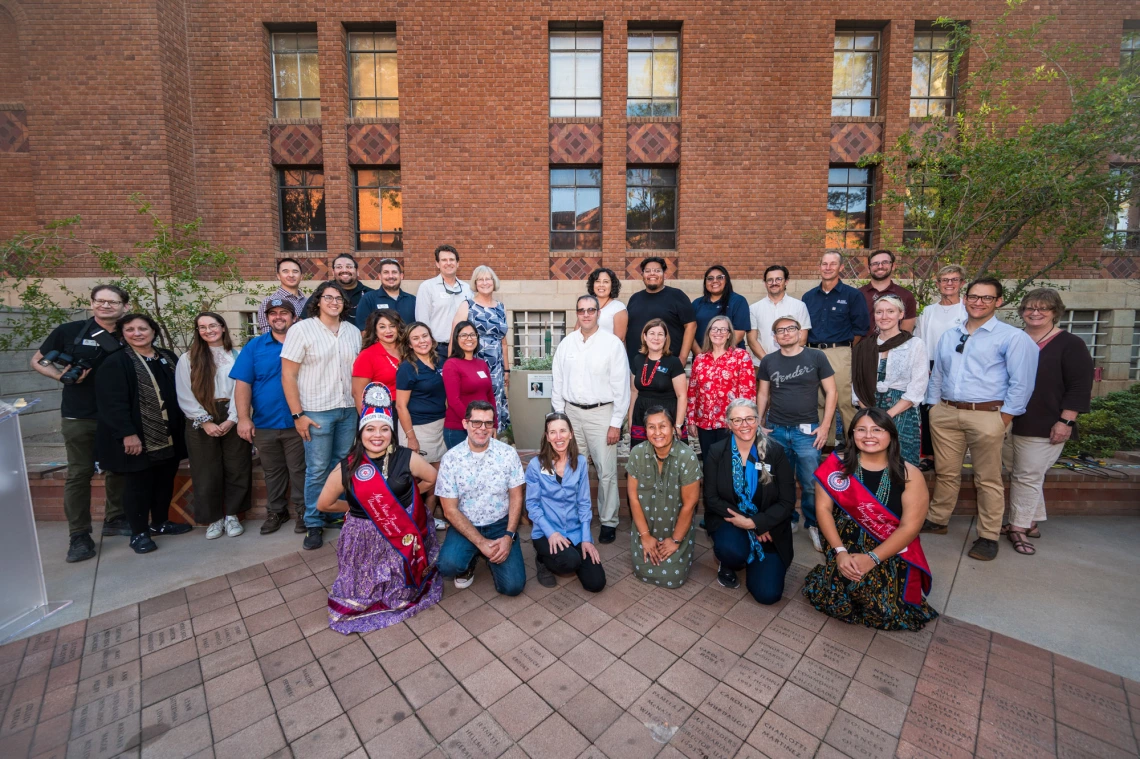
(Photo credit: Mitchell Pe Masilun / UAHS BioCommunications)
On Friday, October 11th, administrators, staff, faculty, students and community members gathered at the Women’s Plaza of Honor to celebrate the 10th anniversary of the Agnese Nelms Haury Program (“Haury Program”). The celebration included a dedication of a garden to honor the life and legacy of Agnese Nelms Haury, a passionate philanthropist with a vision for solving “wicked” problems, and the recognition of seven “Women of Haury” who have significantly contributed to the vision and impact of the program. The opening prayer was offered by Jasmine Lopez, Miss Native American University of Arizona, and the land acknowledgment was provided by the Honorable N. Levi Esquerra, Senior Vice President for Native American Advancement and Tribal Engagement.
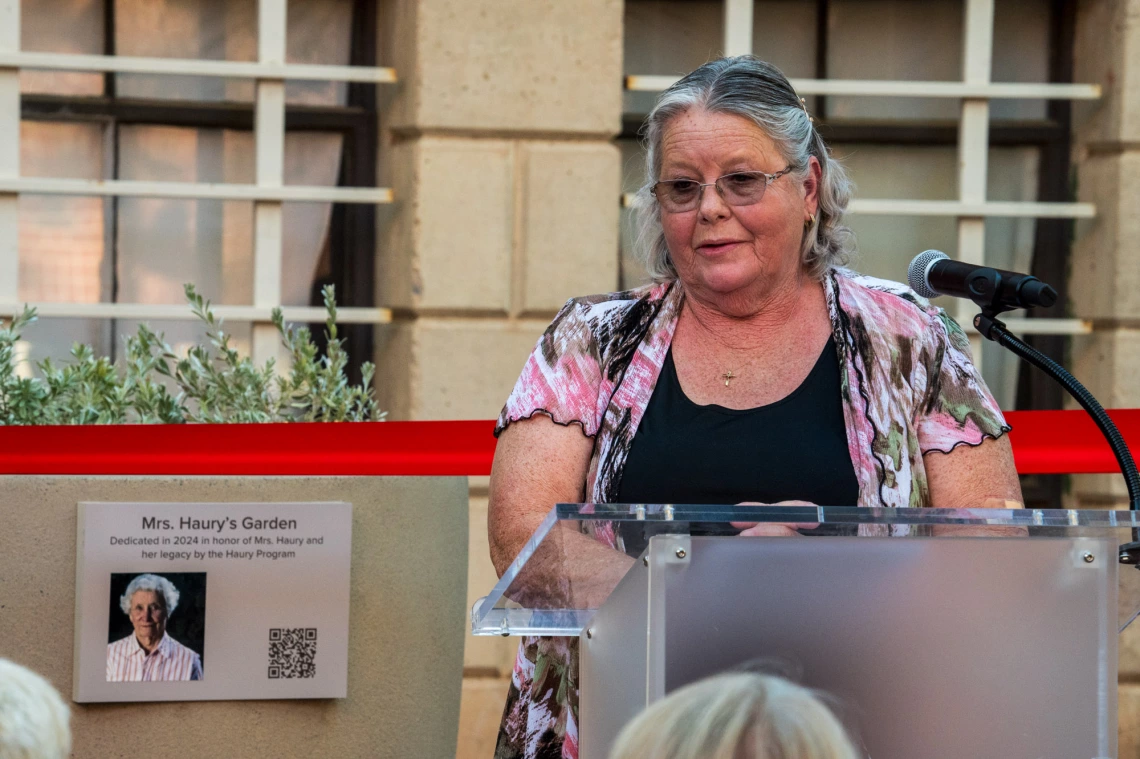
(Tammy Barnett, Haury Program DAF Board; Photo credit: Mitchell Pe Masilun / UAHS BioCommunications)
The Haury Program was established in 2014 when the University of Arizona Foundation became the recipient of a $50 million bequest from the Haury Estate to establish an endowment in support of solving "wicked" societal and environmental problems facing our Southwest region and the world. Ms. Tammy Barnett, who served as a Trustee of the Haury Estate and has been on the Haury Program Donor Advised Fund Board since its formation, knew Mrs. Haury very well: “Aggie was intelligent and eccentric; she was wonderful and generous to others even though she preferred second-hand stores and public transportation for herself.” Ms. Barnett also wanted people to know that Mrs. Haury came to realize the many injustices in the world through her own life experiences gained when accompanying her mother who started Planned Parenthood in Houston, working for the Carnegie Endowment for International Peace and the United Nations, visiting Burma, Peru, Ecuador, and Bolivia, as well as her friendship with Alger Hiss. “She collected articles and filed them away so people could do research on them. She had a wonderful library in her house as well – shelves with books in her bedroom, dining room, kitchen, everywhere! And they were all organized.” In her later years, Mrs. Haury developed Alzheimer’s disease, Ms. Barnett shared: “She used to tell me she wished she was a bird in a corner – with her disease she recognized that she didn’t understand all that was going on. But today, I’m telling you, she is a bird in a corner, and she would be thrilled to death with the garden. She would also be thrilled to death with Toni and Nancy and Nina and everything that they do!”
Ms. Mary Grier, Haury Program Donor Advised Fund Board trustee recalled that Mrs. Haury was a gardener herself: “Her backyard and grounds had all kinds of exotic plants. What I remember specifically is a wall full of Turkish morning glories that somehow got into the country without a proper stamp and she was kind of proud of that, and that might tell you a bit more about her personality.” Ms. Grier continued: “Mrs. Haury was really interested in research and education – using them as tools to empower people to do more, to make the most of their talents. She was known for providing “seed funding” believing that if you help someone plant a seed they will find means elsewhere to nurture and grow even though she was not opposed to sometimes nurturing herself.” Ms. Grier added: “Mrs. Haury appreciated the nurturing power of her wealth, but she did not use it to glorify herself and might even be mortified if she knew her name was on something. She wanted to use it to improve the world and to improve it for humanity. Mrs. Haury indeed epitomizes a person who plants a tree knowing she will not benefit from the shade but future generations will.”
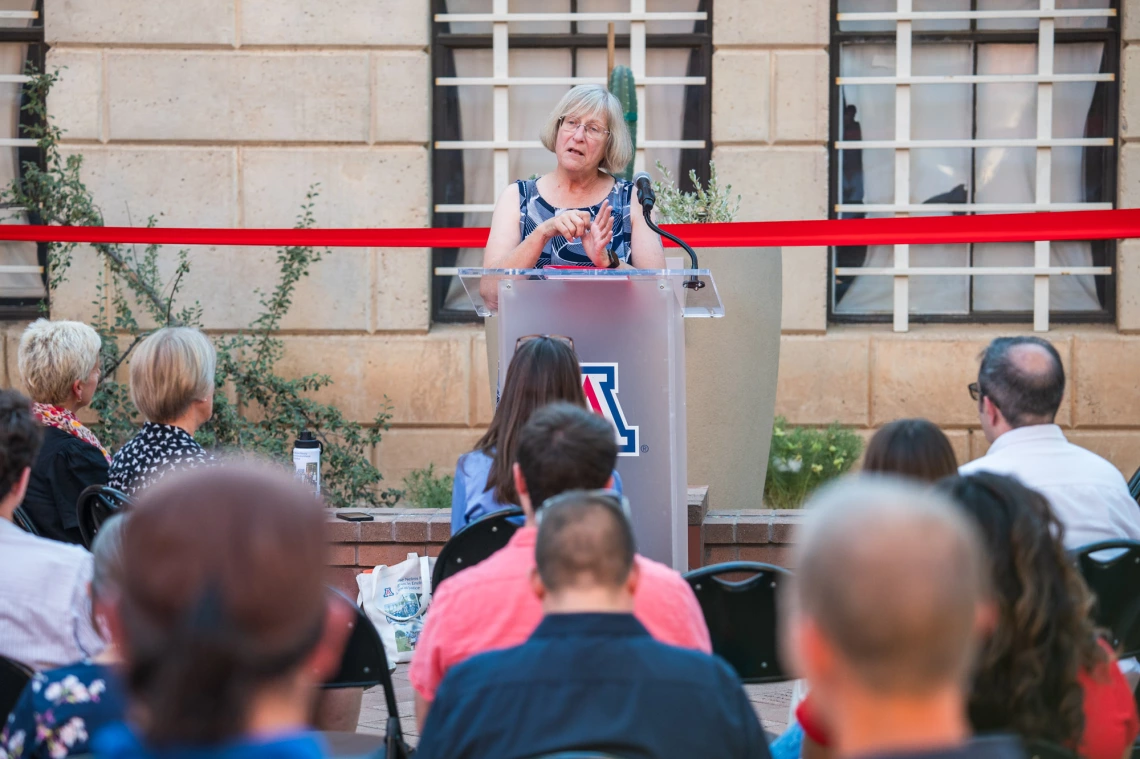
(Mary Grier, Haury Program DAF Board; Photo credit: Mitchell Pe Masilun / UAHS BioCommunications)
Ms. Grier shared that even though Mrs. Haury didn’t leave exact instructions on what to do with the funds, the trustees knew that she would want them to leverage the money, invest into research and people, and would be interested in providing seed money. “We also knew we wanted to work with the University of Arizona,” said Ms. Grier, and thanked the University of Arizona Foundation, which has been an incredible partner through the years. In the first five years, the Haury Program made wonderful investments, Ms. Grier felt, such as the School Garden Workshop Program, Flowers and Bullet’s La Siembra community farm, and A Student’s Journey program, implemented in collaboration with Tohono O’odham Community College. The stage for working with tribal communities was set early with their first Challenge Grant in 2016, which was awarded to Dr. Karletta Chief and Dr. Paloma Beamer for their work with tribal members addressing the Gold King Mine spill. “With working with Native American communities, we can benefit from people who have lived through droughts, who have been resilient and developed ways of being resilient, and we can help bring that knowledge to the world through the University setting. We can help elevate Native scholars, students, and researchers working with communities by partnering with the University and creating relationships that are symbiotic, where respect and gratitude are mutual, and opportunities are endless.”
“Over the years, Agnese Nelms Haury Program has been a vital force in empowering Native communities to foster meaningful change. “A Student’s Journey” aimed to address the low graduation rates of Tohono O’odham students pursuing bachelor’s degrees. Centered on TOCC’s core values, the program empowered students and challenged them to become critical thinkers. They achieved this through workshops and a five-week summer program that included internships and courses focused on Environmental Health Issues through a Social Justice lens. Thanks to the funding from Ages Haury, we were able to develop impactful programming for “A Student’s Journey,” significantly improving the graduation rates of TOCC students. I feel truly blessed to have worked with a program dedicated to empowering native communities in such profound ways. The greatest reward has been witnessing students engage in experiential learning, speak at conferences, and discover their passions. Thank you, the Haury Program, for your unwavering commitment to creating community change. Here’s to many more years of impact!”
- Annamarie Stevens, a Transition Coordinator of “A Student’s Journey” program, Tohono O’odham Community College
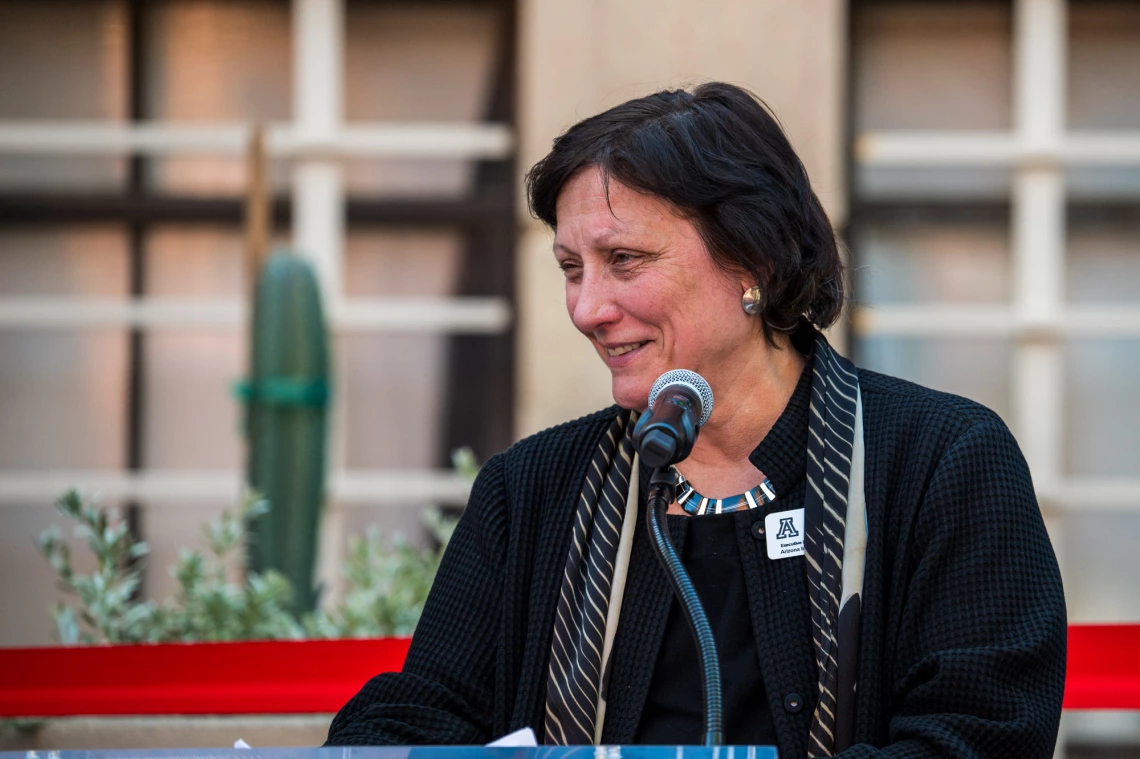
(Toni Massaro, Executive Director, Haury Program; Photo credit: Mitchell Pe Masilun / UAHS BioCommunications)
Prof. Toni Massaro, the current Executive Director of the Haury Program an MC of the program, spoke more about the pivot to the Haury Program’s Indigenous Resilience Initiative in 2020: “COVID 19 hit and it hit hard. Everything changed. It affected us in deep ways. It was scary and disastrous but also generative. We tried to absorb how many Native homes are without water, including on the Navajo Nation. We saw we had a crisis in our backyard, but we also witnessed remarkable resilience of these communities, and saw University of Arizona people on the ground responding to these challenges, many of them from those tribal communities. We saw them forging relationships, and that they needed more resources and support. We witnessed respectful tribal engagement responding to a truly “wicked” problem. Working with the Navajo Water Access Coordination Group, we saw what respectful tribal engagement means for researchers, outreach specialists and funders who want to support communities in ways the communities would welcome.” Prof. Massaro continued: “Trust-based philanthropy is not just an empty phrase – it is work, it is commitment, it is a structure, it is something that needs to be learned and honored every day, and we are still attempting to do that. We are also acknowledging that the land grant commitment of the University of Arizona needs to be action-based, and that’s how our Indigenous Resilience Initiative was born. We understand we won’t solve all the problems but will make some dents!”
Today, the Haury Program supports Indigenous resilience by supporting those working on research and outreach at the University of Arizona, including the Indigenous Resilience Center led by Dr. Chief, Native Pathways and external partnerships. Prof. Massaro added: “It has been a labor of love and gratitude. We did none of our work in the past ten years alone – we work for all of you, for others, and with others. So we recognize and thank the village in which the Haury Program works, both at the University and with the wider world, including tribal nations. You made all of this happen, and we thank you!”
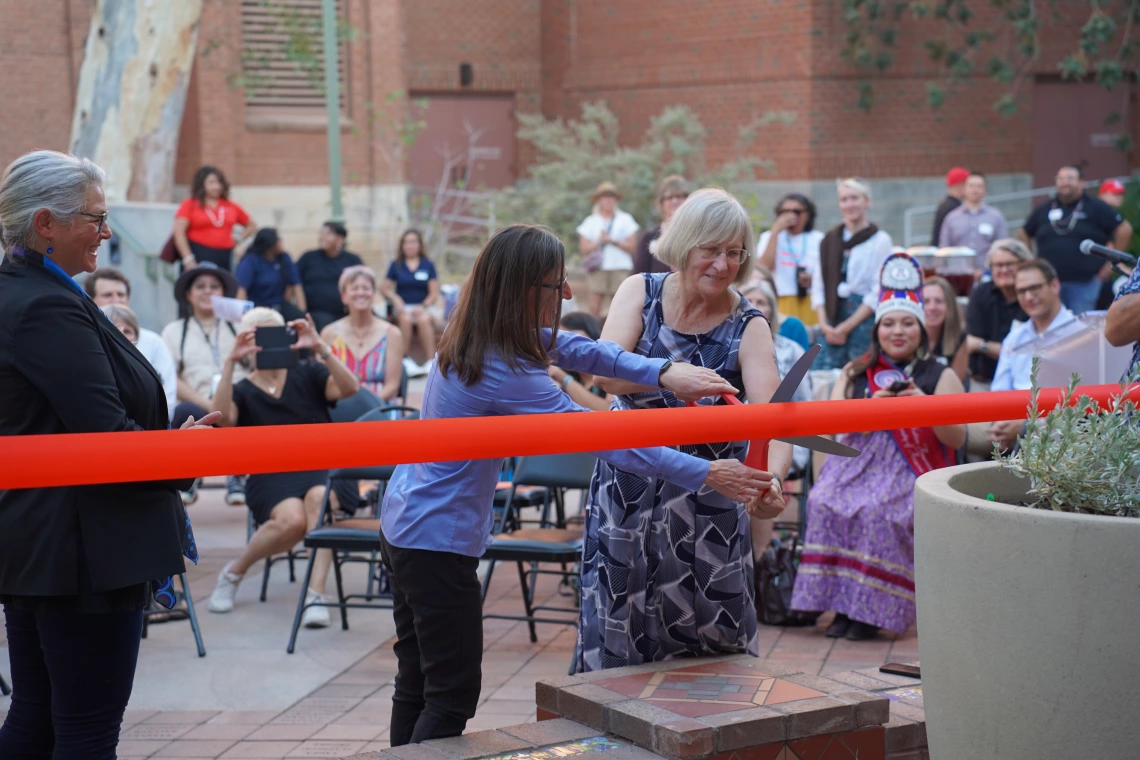
(Mary Grier and Nancy Petersen cutting the ribbon to open Ms. Haury’s garden; Photo credit: Torran Anderson / Indigenous Resilience Center)
Before cutting the ribbon to officially hand over Mrs. Haury’s garden to all to enjoy, Prof. Massaro also recognized Ms. Barnett, Ms. Grier and five other women for their dedication and work for the Haury Program: Vicki Fleischer and Jonelle Vold who worked with the program from the U of A Foundation side; Anna H. Spitz, Haury Program’s first director; Kathryn Whisman, former Haury Program Board member; and Nancy Petersen, who has been with the program almost since its inception and now serves as the Assistant Director and CFO (pictured below, with Mary Grier, another honoree).
Ms. Haury’s Garden at Women’s Plaza of Honor next to the Centennial Hall was designed by Chris Stebe, Campus Landscape Architect. Mr. Stebe’s artist statement reads: “The garden exists as a unique space that at the same time is part of a larger whole. It tells a story of water and culture which support the Haury Program in an abstract but intentional theme. The story is symbolized by the three blue glass circles in three parts connected by a ribbon of stone:
Collection – climate resiliency, a practical solution to support the desert plantings;
Celebration – Mrs. Haury at the center, advocate for innovation, culture and environment;
Cultivation – partnerships with people and nature, providing habitat and community.”
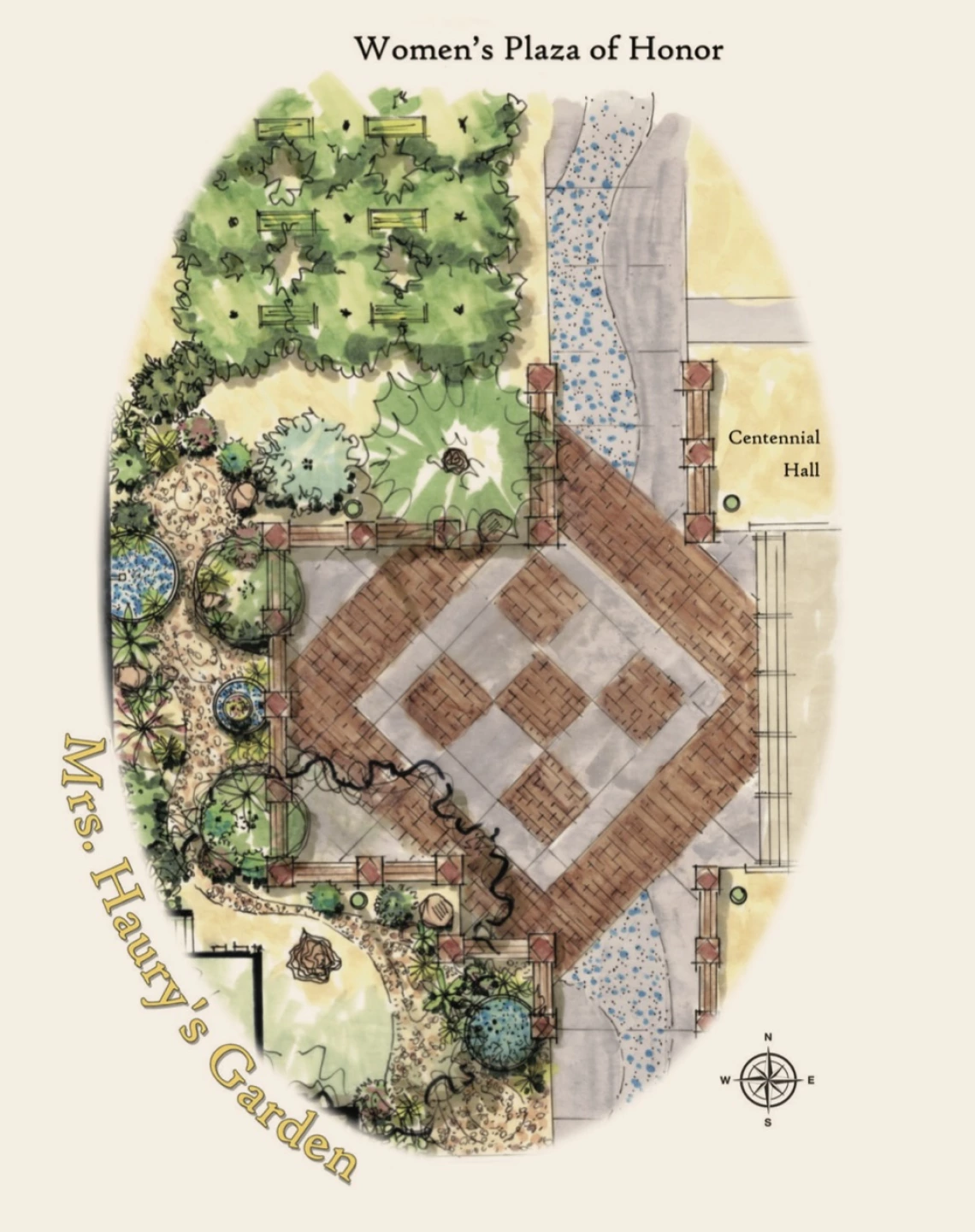
The Haury Program thanks campus partners who allowed for this garden’s space, installation and celebration: College of Social and Behavioral Sciences School of Global Studies and Gender & Women’s Studies, Planning, Design & Construction, as well as the Arizona Institute for Resilience.
The Haury Program is planning a full year of celebration, including the release of a video series highlighting awardees and partners. For more information, follow the Program’s “10 Year Celebration” website and its social media.
